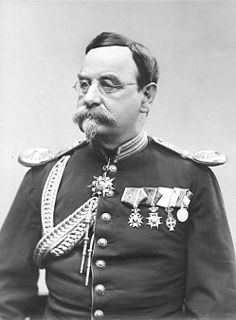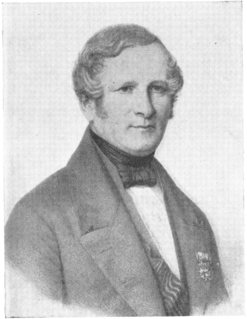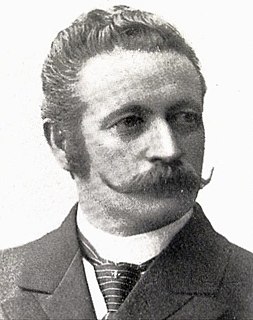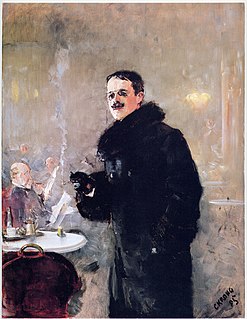
Gerhard Munthe (4 January 1795, Hafslo - 15 December 1876, Luster) was a Norwegian military officer, historian and cartographer. [1]

Gerhard Munthe (4 January 1795, Hafslo - 15 December 1876, Luster) was a Norwegian military officer, historian and cartographer. [1]
He was born to Major Hartvig Kaas Munthe (1766–1830) and his wife, Bolette Christine, née Pavels (1774–1861), the daughter of a minister. He began attending the war school in Christiania (Oslo) in 1807 and was commissioned as a Second Lieutenant in 1811. That same year, he was retained by the Norwegian Mapping and Cadastre Authority. In 1814, he became a First Lieutenant and participated in the Swedish-Norwegian War as a cartographer; mapping the battlefields near Kongsvinger. The following year, he was part of a geographical survey team charged with creating a large topographical map of Scandinavia. In 1825, he became Captain of the Bergen Infantry Brigade, but had to resign his commission in 1830, due to problems with his eyesight. [2]
From 1816 to 1841, he was also an instructor at the Norwegian Military Academy, where he taught drawing and calligraphy. In 1836, he became Director of the manuscript collection at the University of Christiania. During this time, he wrote geographical notes for a translation of the Heimskringla by Jacob Aall. [2] The visual problems that caused him to resign from the service continued to bother him so, from 1841 until his death, he made his living as a farmer at the family home in Sogn. Many artists were regular visitors there, including his nephew, also named Gerhard Munthe.
He is probably best remembered for the trips he made with the artist, Johannes Flintoe, through the Norwegian mountains. The first, in 1819, followed a little known route that had recently been explored by the cartographer, Wilhelm Maximilian Carpelan. In the summer of 1822, he and Flintoe made a second trip, to Hardanger. During the trip, they were joined by the botanist, Matthias Numsen Blytt and the architect, Hans Ditlev Franciscus von Linstow. [3]
He was married four times; to Thora Hansen (1810–1842), then to her sister, Ragnhild Susanne Hansen (1812–1853), followed by Catharine Pauline Suhrland (1823–1869) and Dora Kiønig (1837–1927). In addition to his nephew Gerhard, several other nephews and nieces were famous; notably the engineer, Hartvig Andreas Munthe, the writer, Margrethe Munthe, and the historian, Carl Oscar Munthe.

Ole Herman Johannes Krag was a Norwegian officer and firearms designer.

Frederik Gottschalck Haxthausen Due was a Norwegian military officer and statesman. Born in Trondheim, he entered the military at an early age, and took part in the Swedish-Norwegian War of 1814. After the two countries entered into union, Due was recruited to the Swedish court, where he was appointed Norwegian state secretary in Stockholm in 1823. In 1841 he became the Norwegian prime minister, and acted as interpreter for Charles XIV John. After resigning in 1858, he spent the years until 1871 as an ambassador to Vienna and Munich.

Johannes Flintoe was a Danish-born painter of Norwegian ancestry. He is known for his landscapes, costume studies and historical scenes. His works play a significant role in the transition to romantic nationalism.

Henrich Herman Mejer Foss was a Norwegian military officer and elected official.

Johannes Henrik Nissen was a Norwegian architect.

Carl Oscar Munthe was a Norwegian military officer and historian.
Christopher Morgenstierne Munthe 14 July 1875 – 21 December 1939) was a Norwegian civil servant, military officer and genealogist.

Gerhard Peter Frantz Munthe was a Norwegian painter and illustrator.
Hartvig Andreas Munthe was a Norwegian military officer, engineer and genealogist.

Hartvig Marcus Lassen was a Norwegian editor, educator and literary historian.

Søren Christian Gjessing was a Norwegian military officer and cartographer.

Ole Hartvig Nissen was a Norwegian philologist and educator. He founded Nissen's Girls' School in Christiania in 1849. In 1865 he became director-general in the Ministry of Education, while remaining one of three joint headmasters of Nissen's Girls' School until 1872. In 1873 he was appointed to the prestigious position as rector of Oslo Cathedral School.

Ludvig Kristensen Daa was a Norwegian historian, ethnologist, auditor, editor of magazines and newspapers, educator and politician.

Johan Fredrik Eckersberg was a Norwegian painter most noted for his landscapes. Eckersberg was a prominent figure in the transition from Romanticism to Realism in 19th-century Norwegian art, both as an artistic painter and a teacher at his own art school in Oslo.

Margrethe Aabel Munthe was a Norwegian teacher, children's writer, songwriter and playwright.

Iver Erikssøn Leganger was a Norwegian priest and author.

Kaas is the name of two related Danish noble families from Jutland, which were and are, respectively, two of the preeminent families of the Danish Uradel or ancient high nobility, which were represented in the Council of the Realm. They are known as the elder Kaas family and the younger Kaas family or named for their respective coats of arms. Both families appeared in the middle ages, and they have been noble since time immemorial. Like all old noble families in Scandinavia, the families are untitled, although individual members in the past held the rank of knight, traditionally the highest rank of Scandinavian nobility and reserved for important statesmen, but always of a non-hereditary nature.
Munthe is a surname, mainly used in Scandinavia. Notable people with the surname include:
Ludvig Hanssøn Munthe was the Bishop of the Diocese of Bjørgvin from 1636 to 1649.

Wilhelm Maximilian Carpelan was a Swedish military officer, draftsman, surveyor and cartographer. Together with Johannes Flintoe and Heinrich August Grosch, he was one of the first to survey and describe the interior of Norway; notably Telemark.